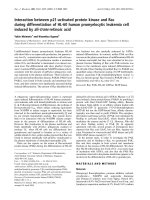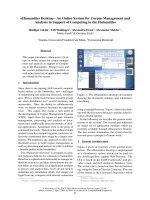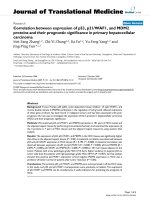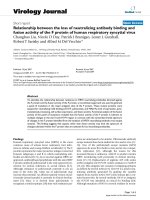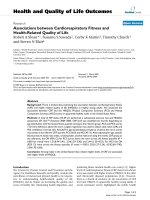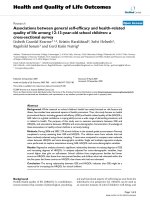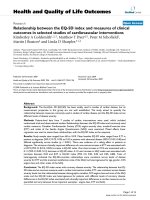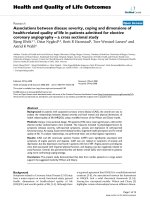Báo cáo hóa học: " Relationship between structural changes, hydrogen content and annealing in stacks of ultrathin Si/Ge amorphous layers" docx
Bạn đang xem bản rút gọn của tài liệu. Xem và tải ngay bản đầy đủ của tài liệu tại đây (578.67 KB, 6 trang )
NANO EXPRESS Open Access
Relationship between structural changes,
hydrogen content and annealing in stacks of
ultrathin Si/Ge amorphous layers
Cesare Frigeri
1*
, Miklós Serényi
2
, Nguyen Quoc Khánh
2
, Attila Csik
3
, Ferenc Riesz
2
, Zoltán Erdélyi
4
, Lucia Nasi
1
,
Dezső László Beke
4
, Hans-Gerd Boyen
5
Abstract
Hydrogenated multilayers (MLs) of a-Si/a-Ge have been analysed to establish the reasons of H release during
annealing that has been seen to bring about structural modifications even up to well-detectable surface
degradation. Analyses carried out on single layers of a-Si and a-Ge show that H is released from its bon d to the
host lattice atom and that it escapes from the layer much more efficiently in a-Ge than in a-Si because of the
smaller binding energy of the H-Ge bond and probably of a greater weakness of the Ge lattice. This should
support the previous hypothesis that the structural degradation of a-Si/a-Ge MLs primary starts with the formation
of H bubbles in the Ge layers.
Introduction
Hydrogenated a-Si and a-Ge layers are key m aterials for
employment in (nano) structures used, e.g., in the technol-
ogy of multi-junction solar cells as a-Ge acts as the low-
band gap absorber while a-Si acts as the high-band gap
one, thus allowing a better exploitation of the solar spec-
trum and the achievement of higher efficiencies [1]. How-
ever, the a-SiGe alloy is now the material of choice as the
low-band gap absorber [2-4]. It allows a higher degree of
freedom as regards the choice of the band gap, as the lat-
ter one can be tailored over some range by changing the
Si/Ge ratio [2,4]. The a-SiGe alloy can be realized from a
sequence of thin a-Si and a-Ge layers by intermixing them
[1,5,6], which is obtained by heat treatments. The latter
treatments are often also used for activating dopants.
Previous studies have shown that the hydrogen content
and annealing conditions can dramatically inf luence the
structural stability of the a-Si/a-Ge multilayers (MLs) pro-
duce d by sputtering and then annealed to produce inter-
mixing [7-9]. It was reported that surface bumps formed,
size and height of which increased with increasing H con-
tent and/or annealing temperature and time [7-9] (see
Figure 1). Craters also formed subsequent to the explosion
of the bumps. The bumps were ascribed to the formation
of bubbles of hydrogen in the MLs [7,8]. The formation of
H bubbles was also suggested by Acco et al. [10] in single
layers of a-Si. It was hypothesized that H c ould be first
released from the Ge layers because of the lower binding
energy of the Ge-H bond with respect to the Si-H one
[7,8]. To check this hypothesis, the MLs were additionally
investigated by IR absorbance and an analysis of the struc-
tural behaviour of single films of a-Si and a-Ge, submitted
to the same annealing as for the MLs pr eviously studied,
was performed. The results are reported in this article.
Experiment
The investigated samples were MLs of alternating layers
of a-Si and a-Ge and single layers of a-Si and of a-Ge.
The latter ones had a thickness of 40 nm. In the former
structure, the 2 × 50 alternating layers were 3 nm thick
each. Both types were sputtered from high-purity crys-
talline silicon and germanium targets in a conventional
high-vacuum sputtering apparatus (Leybold Z400)
pumped to a base pressure better than 5 × 10
-5
Pa. The
target was coupled to a RF generator (13.56 MHz) by a
network for impedance matching between the generator
anditsload.Assubstrate,polished(100)Siwafers
mounted on a water-cooled stage 50 mm away from the
target were used. The substrate temperature was ≤60°C.
* Correspondence:
1
CNR-IMEM Institute, Parco Area delle Scienze 37/A, 43100 Parma, Italy
Full list of author information is available at the end of the article
Frigeri et al. Nanoscale Research Letters 2011, 6:189
/>© 2011 Frigeri et al; licensee Springer. This is an Open Access article distributed under the terms of the Creative Comm ons Attribution
License ( which pe rmits u nrestrict ed use, distribution, and reprod uction in any medium,
provided the origina l work is properly cited.
It was estimated from measurements of the shift of the
emission spectra of InP or GaAs during the deposition
of AR (anti reflection) coating for laserdiode, carried out
under identical condi tions as those used here, by apply-
ing the rule 4 nm = 10°C. The temperature increase was
always ≤40°C. Sputtering was done with a mixture of
high-purity argon and hydrogen gases. No pressure fluc-
tuation was observed. Plasma pressure of 2 Pa and a
1500 V dc wall potential were applied to sputter the tar-
gets, yielding a sputtering rate of 6.3 and 13.5 nm/min
for a-Si and a-Ge, respectively. Hydrogenation was car-
ried out by letting hydrogen flow into the depo sition
chamber at flow rates of 0.4, 0.8 and 1.5 ml/min. The se
values correspond to the measured 0.38, 0.78 and 1.46%
partial of total pressure, respectively (all gauge readings
were corrected by gas-sensitivity factors). The samples
were annealed in high-purity (99.999%) argo n at 350 or
400°C for 1, 4 and 10 h. The choice of s uch tempera-
tures as the optimal ones for the purpose of this experi-
ment was suggested by the findings of previous studies
[7-9]. In fact, it w as observed that annealing at 450°C
causes such a g reat degradation of the surface that
nearly 53% of it was cov ered by bumps and craters as
large as 9 μm, with the craters as deep as the whole ML
[7,8]. On the other hand, for annealing temperature o f
250°C the formation of the craters rarely occurs only for
very high H flow rate (6 ml/min) [7,8], thus making it
difficult to evaluate whether the decrease of H content
in the samples can be associated with craters for the
lower H flow rates considered here. No crater was ever
detected for annealing temperatures lower than 250°C.
Non-hydrogenated samples were also sputtered to use
as reference samples; they were annealed under the
same conditions as the hydrogenated ones.
The samples were analysed by elastic recoil detection
analysis (ERDA), atomic force microscopy (AFM), infrared
(IR) absorption and Makyoh topography (MT). For ERDA,
the 1.6 MeV
4
He
+
beam av ailable at the 5 Me V Van de
Graaff accelerator (Research Institute for Nuclear and Par-
ticles Physics, Budapest, Hungary) ha d been applied to
measure t he hydrogen in the samples. The hydrogen
recoiled from the sample by He ions was collected by sur-
face-biased Si detector placed at a detecting angle of 10°
with regard to the beam direction, while the sample was
tilted to 85° from the normal. Mylar foil with thickness of
6 μm was placed in front of the ERDA detector to stop the
forward-scattered He ions. Therefore, the ERDA spectra of
the H are almost background-free. Low ion current (ca. 6
nA) has been used to avoid beam heating, i. e. the escap e
of H from the sample at a high temperature. Evaluation of
ERDA spectra was done by the RBX p rogram developed
by Kótai [11]. The in-depth spatial resolution of ERDA is
approximately 20 nm [12]. Since E RDA is applied here
only to the single layers and the Si substrates do not con-
tain H, such error on t he depth where the ERDA signal
comes from does not impair the results regarding the pre-
sence and concentration of H. The region between chan-
nels 120 and 100 (see next section) corresponds to a depth
of 40 nm fro m the surface. The relative error on concen-
tration is a few per cent. Therefore, the method is suitable
with regard to detecting the tendency of the H change in
the samples as presented in the next section. However, the
absolute error is worse because of the lack of a calibration
sample having a well-kn own H content. A ca rbon layer
containing H was thus used as a calibration sample.
Owing to the small cross section of C for He ion, the error
on the absolute H content calculated by this method is
about 25%. As stated earlier, it should be noticed that such
an error on the absolute concentration does not affect any
interpretation of the tendency of the H changes. A
VEEC O Dimension 3100 in tapping mode was employed
for the AFM analysis. IR absorbance gave information on
how H bonds to Si and Ge before and after annealing. An
Oriel Cornerstone instrument was used. Makyoh topogra-
phy [13] was employed to measure the mean curvature
radius of the films to evaluate their stress status using the
Stoney formu la [13- 15]. A Young’s modulus and Poisson
ratio of 130 GPa [16,17] and 0.28 [16,17], respectively,
were assumed for the (100) Si wafer.
Results and discussion
The calibration of the sputtering apparatus as regards
the incorporation of H was done using ERDA by means
ofthesinglelayersofa-Sianda-Ge.Figure2ashows
the ERDA spectra for the non-annealed a-Si layers
hydrogenated at different flow rates. The signal of the
recoiled H atoms from the sample surface locates at
channel 120. Behind the surface, the distribution of H
seems to be reasonably homogeneous in the whole
layer. Small peaks at channels 97 and 120 can be
0
20
40
60
80
100
0
2
4
6
8
10
0 1 2 3 4 5 6 7
Bumps height (nm)
Bumps size
(
Pm
)
H flow rate (ml/min)
Figure 1 Bumps height (dash blue line) and size (solid black
line) as a function of the H flow rate in a-Si/a-Ge ML samples
annealed at 350°C for 10 h.
Frigeri et al. Nanoscale Research Letters 2011, 6:189
/>Page 2 of 6
associated with the contamination at the surface either of
the deposited layer or of the substrate. The tail behind
the H peak is due to t he multiple scattering, which the
RBX code is not yet able to simulate. Similar spectra
were obtained for a-Ge. By using the simulation program
of ref. [11], the calibration curves of Figure 2b giving the
incorporated at.% of H a s a fu nction of the H flow rate
were obtain ed. The increase in H c oncentrat ion in a-Si
already tends to slow down significantly between 1 and
1.5 ml/min flow rate (0.78 and 1.46% partial of total pres-
sure), reaching a maximum value of 17 at.%. In a-Ge, the
same slowing down trend is observed for the same flow
rate values reach ing a maximum value of only about 7 at.
% (Figure 2b).
A typical set of IR absorbance spectra in the stretching
mode range of the wave number is shown in Figure 3.
The spectra refer to MLs hydrogenated with a H flow
rate of 0.8 ml/min: B1 is the spectrum of the as-depos-
ited layer, B2 the spectrum of the ML annealed at 400°C
for 1 h and B3 the one of the sample annealed at 400°C
for 10 h. Spectrum B 1 shows the peaks at 1880 and at
2010 cm
-1
, which are the fingerprints of the monohy-
dride bonds of H to Ge and Si, respectively [10,18-20].
The shape of the Si-H peak indicates that the peak of
the Si di-hydride bond, Si-H
2
, at about 2140 cm
-1
coul d
also exist hidden in the tail of the Si-H peak at high
wave numbers. The shift with respect to the standard
value of 2100 cm
-1
canbeduetothepresenceof(Si-
H
2
)
n
poly-hydrides [10,18] or to a possible contamina-
tion of the hydrides by oxygen [18]. The latter contami-
nation, if any, may come from o xygen residues in the
sputtering chamber. The presence of the Ge di-hydride
on the high wave number side of the Ge-H peak is not
certain. The possible existence of Si-H
2
bonds could be
suggeste d by spe ctrum B2 also showing a peak around
2140 cm
-1
. Figure 3 shows that, upon annealing, the Si-
H and Ge-H bonds break with consequent release of H.
H has totally been released from Ge already after 1 h
annealing, while it still remains somewhat bound to Si
as mono- and di-hydride. After 10 h annealing, H is
totally released from Si as well.
The different release efficiencies of H in a-Si and a-Ge
were also studied with ERDA by using the 40-nm-thick
single films. The results are summarized in Figure 4 for
the case of annealing at 350°C for times of 1 and 4 h.
0
0,5
1
4
6
8
10
12
14
16
18
20
0 0,2 0,4 0,6 0,8 1 1,2 1,4 1,6
H conct. [at %]
H flow rate (ml/min)
a-Si
a-Ge
b
)
80 100 120 14
0
0
50
100
150
200
250
300
#15
#8
#4
H
1.6 MeV
4
He
+
ERD ANALYSIS, 4=10
o
Tilt=85
o
YIELD (counts/ch)
CHANNEL NUMBER
a)
Figure 2 Calibration of H incorporation with ERDA. (a) 1. 6 MeV
4
He
+
ERDA spectra of H in the a-Si single layers hydrogenated at
flow rates of 0.4, 0.8 and 1.5 ml/min (#4, #8 and #15, respectively, in
the plot). (b) Total H concentration in a-Si (solid black line) and a-
Ge (dash blue line) layers as a function of the H flow rate as
determined by ERDA.
Q
Figure 3 IR absorbance spectra in the stretching mode range
of the wave number for a-Si/a-Ge MLs sputtered under H flow
rate of 0.8 ml/min. B1 is the spectrum of the as-deposited layer, B2
the spectrum after annealing at 400°C for 1 h and B3 the one after
annealing at 400°C for 10 h.
Frigeri et al. Nanoscale Research Letters 2011, 6:189
/>Page 3 of 6
Irrespective of the initial H content (i.e. H flow rate) in
the as-deposited films, a decrease in the H concentration
upon annealing is observed, which is greater for longer
annealing time. However, such a decrease is more effec-
tive in the case of t he a-Ge film, as can be seen in Figure
5 that compares the decreases in H concentration in the
two types of ma terial (sputtered wi th H flow r ate of 0.8
ml/min) as a function of the annealing time at 350°C. In
a-Ge, the decrease is 85% with respect to the non-
annealed reference sample (from 5.5 to 0.8 at.%) just
after 1 h, whereas it is only 35% for a-Si (from 14.7 to 9.6
at.%). By annealing for 4 h only a small further decrease
in the H concentration of 3-4% is observed in b oth Si
and Ge. This indicates that the release of H in the a-Ge
layer was highly effective, and that its escape from the
layer was very fast. Evidence for this is given in Figure 6
which shows the surface morphology of the two types of
layer after annealing. For the same annealing time, either
1 or 4 h, the S i layer mainly exhibits surface bumps after
annealing, indicating that H is still in the film, though
part ially gathered in bubbles, whi lst the Ge layer exhibits
mostly craters, i.e. exploded H bubbles, as d eep as the
layer, suggesting that nearly all H has escape d in agree-
ment with the E RDA results (Figures 4 and 5). The Si
film also contains some broken bumps (one is visible in
Figure 6a) which would explain the 35-38% decrease of
the H concentration detected by ERDA.
The structure degradation that produces craters is
caused by two mecha nisms in succession. First, the
release of H and the formation of the H bubbles. Sec-
ond, the creation of craters if the initial H co ntent is
very high and/or the annealing conditions are very
severe [7-9]. As to the release of H, the above men-
tioned results are evidence that it is more efficient and
faster in the a-Ge layers. This is in agreement with the
previous literature according to which the binding
energy of the Ge-H bond is smaller than that of the S i-
H bond [4,21-24]. In particular, Tsu et al. [24] found
that it is 69 kcal/mole for Ge-H and 76 kal/mole for S i-
H. The faster release of H in a-Ge would cause a faster
increase in the size of the H bubbles to the critical value
for their explosion and formation of craters. The results
of this study wo uld confirm that the origin of the struc-
tural degradation of the MLs of a-Si/a-Ge o bserved in
previous studies (Figure 1 and refs. [7-9]) very likely pri-
marily starts in the Ge layers mostly because of the
lower binding energy of H-Ge with respect to H-Si
bonds.
It should be noticed that crater formation could also
befavouredbyintrinsicstresses.Thesamplestressas
measured by MT was always compressive, as found by
others [25-27], with values of about 1, 0.15 and 0.33
GPa for as-deposited, non-hydrogenated single layers of
a-Si, a-Ge and a-Si/a-Ge MLs, respectively. For a-Si, this
result is in reasonable agreement with the literature data
[27,28]. Not much is known for a-Ge. As expected, the
stress for the MLs is in between those of the single
layers. Nickel and Jackson [29] have speculated tha t the
strain released as a consequence of the b reak of the H-
host atom bonds can be re-created by its propagation
through the amorphous network to the neighbouring
atoms and reconstruction of strained Si-Si bonds. They
concluded that the average network strain remains inde-
pendent of the H concentration and annealing as well
[29]. It might thus be assumed that the annealed hydro-
genated samples do not change their stress significantly
with resp ect to that measured in the as-deposit ed ones.
Other findings suggest that annealing causes stress
relieve in hydrogenated amorphous Si/Ge MLs [30].
Should there be changes in these samples, it is very
likely that the intrinsic stress of a-Ge always remains
smaller than the one of a-Si upon annealing owing to
the great difference between the values of the as-
0,0 0,2 0,4 0,6 0,8 1,0 1,2 1,4 1,6
0,0
0,3
0,6
0,9
3
6
9
12
15
18
Ge: as-deposited
Ge: 350 C, 1 hour
Ge: 350 C, 4 hours
Si: as-deposited
Si: 350 C, 1 hour
Si: 350 C, 4 hours
H conct. [at
%
]
H
2
flow rate [ml/minute]
Figure 4 H concentration, as determined with ERDA, as a
function of the H flow rate in a-Si and a-Ge single layers
before and after annealing at 350°C for 1 and 4 h.
0
2
4
6
8
10
12
14
0 1 2 3 4
5
H conct. [at %]
Annealing time (h)
a-Si
a-Ge
Figure 5 H concentration, extracted from Figure 4, as a
function of the annealing time at 350°C in a-Si (solid black
line) and a-Ge (dash blue line) single layers hydrogenated at
0.8 ml/min.
Frigeri et al. Nanoscale Research Letters 2011, 6:189
/>Page 4 of 6
deposited samples. The contribution of stress sh ould
thus play a minor role in differentiating the formation
rate of the craters in a-Si anda-Ge.Furtherinvestiga-
tions are underway to better clarify this point.
Abbreviations
AFM: atomic force microscopy; ERDA: elastic recoil detection analysis; IR:
infrared; MLs: multilayers; MT: Makyoh topography.
Acknowledgements
This study was supported by the Scientific Cooperation Agreement between
MTA (Hungary) and CNR (Italy) under the contract MTA 1102, as well as by
OTKA grant Nos. K-67969, CK-80126, K 68534 and TAMOP 4.2.1-08/1- 2008-
003 project (implemented through the New Hungary Development Plan co-
financed by the European Social Fund, and the European Regional
Development Fund). Z. Erdélyi is a grantee of the ‘Bolyai János’ scholarship.
Author details
1
CNR-IMEM Institute, Parco Area delle Scienze 37/A, 43100 Parma, Italy
2
Research Institute for Technical Physics and Materials Science, Hungarian
Academy of Sciences, P.O. Box 49, H-1525 Budapest, Hungary
3
Institute of
Nuclear Research of the Hungarian Academy of Sciences, P.O. Box 51, H-
4001 Debrecen, Hungary
4
Department of Solid State Physics, University of
Debrecen, P.O. Box 2, H-4010 Debrecen, Hungary
5
Institute for Materials
Research (IMO), Hasselt University, Diepenbeek, Belgium
Authors’ contributions
CF coordinated the interpretation of the results and wrote the manuscript,
MS grew the samples by sputtering and suggested the experiment, NQK
performed the ERDA measurements, ACs carried out the sample heating
experiments, FR did the Makyoh topography measurements, ZE participated
in the coordination-realisation of the IR measurements, LN made the AFM
work, DLB participated in the design of the study, H-GB performed the IR
measurements.
Competing interests
The authors declare that they have no competing interests.
Received: 9 September 2010 Accepted: 1 March 2011
Published: 1 March 2011
References
1. Arrais A, Benzi P, Bettizzo E, Damaria C: Characterization of hydrogenated
amorphous germanium compounds obtained by x-ray chemical vapor
deposition of germane: Effect of the irradiation dose on optical
parameters and structural order. J Appl Phys 2007, 102:104905.
2. Bouizem Y, Belfedal A, Sib JD, Kebab A, Chahed L: Hydrogen-bonding
configuration effects on the optoelectronic properties of glow discharge
a-Si
1-x
Ge
x
:H with large x. J Phys Condens Matter 2007, 19:356215.
3. Jobson KW, Wells J-PR, Schropp REI, Carder DA, Philips PJ, Dijkhuis JI:
Relaxation processes of the Ge-H stretch modes in hydrogenated
amorphous germanium. Phys Rev B 2006, 73:155202.
4. Cohen JD: Light-induced defects in hydrogenated amorphous silicon
germanium alloys. Sol Energy Mater Sol Cells 2003, 78 :399.
5. Sameshima T, Watanabe H, Kanno H, Sadoh T, Miyao M: Pulsed laser
crystallization of silicon-germanium films. Thin Solid Films 2005, 487:67.
6. Abo Ghazala MS: Composition and electronic properties of a-SiGe:H
alloys produced from ultrathin layers of a-Si:H/a-Ge:H. Physica B 2000,
293:132.
7. Frigeri C, Nasi L, Serényi M, Csik A, Erdélyi Z, Beke DL: AFM and TEM study
of hydrogenated sputtered Si/Ge multilayers. Superlatt Microstruct 2009,
45:475.
8. Frigeri AC, Serényi M, Csik A, Erdélyi Z, Beke DL, Nasi L: Structural
modifications induced in hydrogenated amorphous Si/Ge multilayers by
heat treatments. J Mater Sci Mater Electron 2008, 19:S289.
9. Csik A, Serényi M, Erdélyi Z, Nemcsics A, Cserhati C, Langer GA, Beke DL,
Frigeri C, Simon A: Investigation of thermal stability of hydrogenated
amorphous Si/Ge multilayers. Vacuum 2010, 84:137.
10. Acco S, Williamson DL, Stolk PA, Saris FW, van den Boogaard MJ, Sinke WC,
van der Weg WF, Roorda S, Zalm PC: Hydrogen solubility and network
stability in amorphous silicon. Phys Rev B 1996, 53:4415.
11. Kótai E: In Proceedings of the 14th International Conference on the Application
of Accelerators in Research and Industry, 1996, Denton, USA. Edited by:
Duggan JL, Morgan IL. New York: AIP Press; 1997:631.
12. Szilágyi E, Pászti F, Amsel G: Theoretical approximations for depth
resolution calculations in IBA methods. Nucl Instrum Methods B 1995,
100:103.
a) b)
Figure 6 AFM amplitude image of (a) a-Si and (b) a-Ge single layer after annealing at 350°C for 4 h. H flow rate 1.5 ml/min. In (a) bumps
(close bubbles with H still inside) are predominant (only one is broken). In (b) large craters, i.e. exploded bumps with escape of H, are by far
predominant. Very tiny bumps are also present.
Frigeri et al. Nanoscale Research Letters 2011, 6:189
/>Page 5 of 6
13. Riesz F: Makyoh topography for the morphological study of compound
semiconductor wafers and structures. Mater Sci Eng B 2001, 80:220.
14. Stoney GC: The Tension of Metallic Films Deposited by Electrolysis. Proc
R Soc Lond A 1909, 32:172.
15. Nix WD: Mechanical properties of thin films. Metall Trans A 1989, 20:2217.
16. Wertman JJ, Evans RA: Young’s Modulus, Shear Modulus, and Poisson’s
Ratio in Silicon and Germanium. J Appl Phys 1965, 36:153.
17. [ />18. Daouahi M, Zellama K, Bouchriha H, Elkaïm P: Effect of the hydrogen
dilution on the local microstructure in hydrogenated amorphous silicon
films deposited by radiofrequency magnetron sputtering. Eur Phys J AP
2000, 10:185.
19. Manfredotti C, Fizzotti F, Pastorino M, Polesello P, Vittone E: Influence of
hydrogen-bonding configurations on the physical properties of
hydrogenated amorphous silicon. Phys Rev B 1994, 50:18046.
20. Soukup RJ, Ianno NJ, Darveau SA, Exstrom CL: Thin films of a-SiGe:H with
device quality properties prepared by a novel hollow cathode
deposition technique. Sol Energy Mater Sol Cells 2005, 87:87.
21. Beyer W: Incorporation and thermal stability of hydrogen in amorphous
silicon and germanium. J Non-Cryst Solids 1996, 198-200:40.
22. Chou YP, Lee SC: Structural, optical, and electrical properties of
hydrogenated amorphous silicon germanium alloys. J Appl Phys 1998,
83:4111.
23. Walther T, Humphreys CJ, Cullis AG, Robbins DJ: A study of interdiffusion
and germanium segregation in low-pressure chemical vapour
deposition of SiGe/Si quantum wells. Inst Phys Conf Ser 1997, 157:47.
24. Tsu R, Martin D, Gonzales-Hernandez J, Ovshinsky SR: Passivation of
dangling bonds in amorphous Si and Ge by gas adsorption. Phys Rev B
1987, 35:2385.
25. Friesen C, Thompson CV: Reversible Stress Relaxation during
Precoalescence Interruptions of Volmer-Weber Thin Film Growth. Phys
Rev Lett 2002, 89:126103.
26. Chason E, Sheldon BW, Freund LB, Floro JA, Hearne SJ: Origin of
Compressive Residual Stress in Polycrystalline Thin Films. Phys Rev Lett
2002, 88:156103.
27. Tzanetakis P: Metastable volume changes of hydrogenated amorphous
silicon and silicon-germanium alloys produced by exposure to light. Sol
Energy Mater Sol Cells 2003, 78:369.
28. Gotoh T, Nonomura S, Nishio M, Nitta S, Kondo M, Matsuda A:
Experimental evidence of photoinduced expansion in hydrogenated
amorphous silicon using bending detected optical lever method. Appl
Phys Lett 1998, 77:2978.
29. Nickel NH, Jackson WB: Hydrogen-mediated creation and annihilation of
strain in amorphous silicon. Phys Rev B 1995, 51:4872.
30. Tripathi S, Brajpuriya R, Sharma A, Shripathi T, Chaudhari SM: Structural
characterization of annealed Si/Ge nanostructures using Raman
spectroscopy, XRR and AFM. J Phys D Appl Phys 2006, 39:4848.
doi:10.1186/1556-276X-6-189
Cite this article as: Frigeri et al.: Relationship between structural
changes, hydrogen content and annealing in stacks of ultrathin Si/Ge
amorphous layers. Nanoscale Research Letters 2011 6:189.
Submit your manuscript to a
journal and benefi t from:
7 Convenient online submission
7 Rigorous peer review
7 Immediate publication on acceptance
7 Open access: articles freely available online
7 High visibility within the fi eld
7 Retaining the copyright to your article
Submit your next manuscript at 7 springeropen.com
Frigeri et al. Nanoscale Research Letters 2011, 6:189
/>Page 6 of 6
